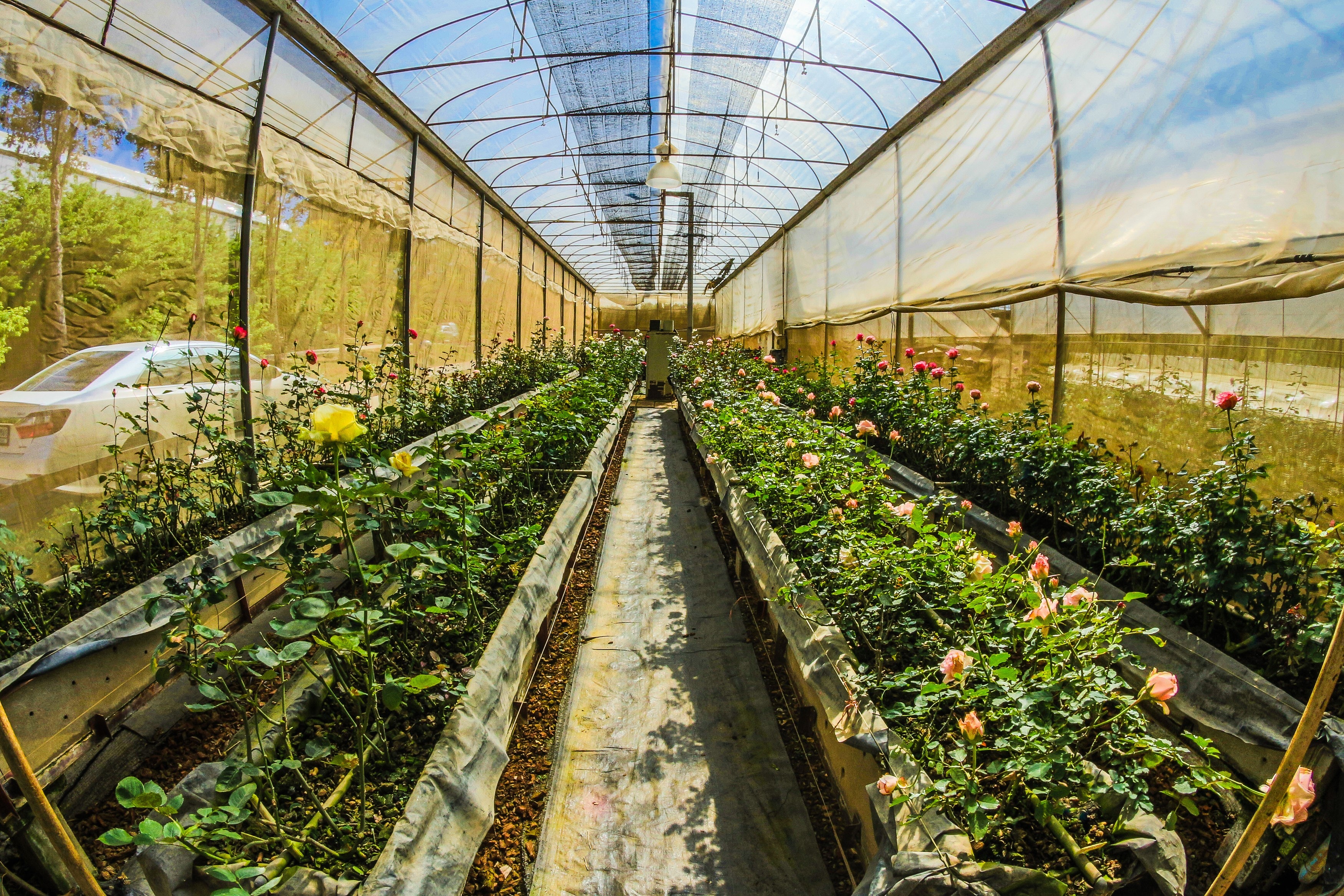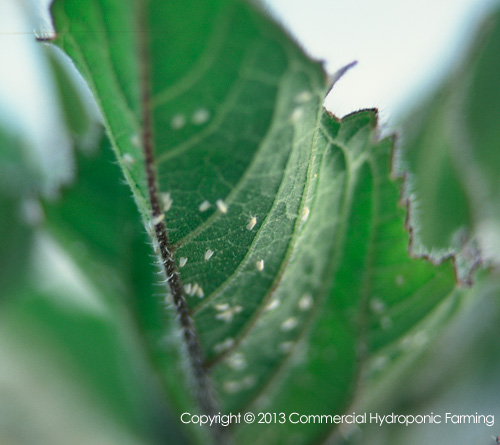The effect of high intensity radiation on plant growth in greenhouses.
High intensity radiation is more common in equatorial regions than cold weather climates. This is because of the angle the sun rays hit the soil surface. It does not mean that the intensity of radiation is lower in South Africa than Nigeria per se. It also depends on the angle and direction of the land, covering material and local weather conditions. We are discussing high intensity radiation on plants throughout the whole year. It does not mean winter sun has low intensity per se. You have to distinguish between daylight length vs light intensity.
Single leaves are light saturated at quite low light energy levels. The conversion of light in photosynthesis becomes more efficient as light intensity decreases. GAASTRA (1959)1)GAASTRA, P. 1959. Photosynthesis of crop plants as influenced by light, carbon dioxide, temperature and stomatal diffusion resistance. Med. Landbou. Wageningen 59, 1-68. found that leaves can achieve efficiencies approaching 20% at 10-20% full light levels.
When exposing leaves to full sunlight with enriched CO2, efficiencies of 4% are common (BONNER, 1962)2)BONNER, J. 1962. The upper limit of crop yield, Science 137, 11-15.. Rice and wheat can achieve 2-4% efficiency in full sunlight under field conditions. The average conversion efficiency is about 2%. It must be noted that not all plants are equally efficient. C4 (maize, sugarcane, chrysanthemum etc.) plants are in general much more efficient than C3 plants. C3 plants have a higher respiration and in some cases release CO2 in the day. Geneticists are looking into breeding C4 pathways into C3 plants to make them more efficient.
If food manufacture by plants become less efficient as light intensity increases, then why is yield usually higher with maximum sunlight. Higher sunlight is required in order to bring all leaves in a plant canopy to their maximum rate. There is competition between leaves in a dense canopy (LOOMIS et al., 1971)3)LOOMIS et al., 1971. Agricultural Productivity. Ann Rev. Plant Physiol. 22, 431-469.. The upper leaves may be saturated with light but the lower leaves are shaded. The quality of the radiation may be different inside the canopy. As the sun moves across the sky, different parts of the greenhouse bench will be radiated at different times of the day and the time when this occurs is important. If it is assumed that no other factors are limiting, growth rates of the crop will usually be highest with maximum sunlight. Sunlight is the single most important factor limiting greenhouse production. Not all species tolerate full sunlight. African violet, orchards and many other foliage plants will be damaged by fill sunlight.
It is sometimes desirable to reduce energy for purpose of improving quality or adaptation to conditions experienced in the consumer’s hands. Many ornamental greenhouse plants show similar variations in response to radiant energy.
Light requirements vary with species, stage of growth and previous history. If two identical plants are placed in different environments for a period, and then both are returned to the same conditions for each, they will not respond the same. Plants preconditioned to high light will perform better under the same conditions. the same applies to plants conditioned to low energy levels. These responses may be expected if the environment factor is a different water treatment, fertilizer treatment or CO2 concentration. Previous history, then, becomes very important when a problem is being diagnosed and is very important with foliage plants that will be subject to adverse conditions of dry atmosphere and low light in a home (VLHOHOS & BOODLEY, 1974)4)VLOHOS, J., & BOODLEY, J.W. 1974. Acclimatisation of Brassicas actinophylla and Fiscus nitiola to interior environmental conditions, N.Y. State Flower Industries Bull. 50, 1-5, 7.
Plant temperature and water loss in relation to high intensity radiation
Less than 5% of total sunlight is used for plant growth. The other 95% the plant receives, must be eliminated or discarded. Note that the energy not used for photosynthesis heats the plant up. This is not always a bad thing, but in most cases the surrounding air provides enough heat that is comfortable for the plant. The exxess heat is removed through:
- Reflection from leaves and stems
- Transmission
- Convection and
- Evaporation (the most important of them all)
Evaporation converts water into a gas which is released through the stomata. Heat is released in the form of gas which is very efficient and that is why greenhouses is so humid and hot. It is estimated that 70-90% of heat is released through evaporation. Now one can understand why ventilation is so important inside a greenhouse. Restrict the evaporation process by too high humidity and the plant heats up very quickly. A crucial time is when the stomata close naturally due to stress. High intensity radiation can cause the stomata to close although it has to cool off. The best way to prevent this is to diffuse the sunlight inside the greenhouse.
Since water is freely available in hydroponic systems, the rate of water loss is directly correlated with the intensity of radiation or sunlight. So water loss will follow a curve closely related to a curve for solar energy. That is why one of the best fertigation methods is to control the EC by correlating it with radiation the plant receives. A plant will wilt as soon as the root system cannot provide enough water to meet the evaporation rate.
If you compare artificial turf with natural grass you will find that the surface of the turf is much higher than the grass. Even if the turf is the same colour as the grass. An empty tunnel will be much hotter inside than a tunnel with a crop in. That is how effective the conversion from water to gas is in removing stored energy into the atmosphere.
Commercial plants absorb radiation between wavelengths 300-700 nm and again at wavelengths longer than 2000 nm. In the region where sunlight is most intense, reflectance and transmission by green plants increase. This method prevents the problem of too much energy entering the plant and heating it up. A classic example is between red and white carnation flowers. The red flowers are hotter than the surrounding air in full sunlight while the white flowers are lower than the surrounding air.
In the next article I will discus low intensity radiation and its effect on flowering.
References
| ↑1 | GAASTRA, P. 1959. Photosynthesis of crop plants as influenced by light, carbon dioxide, temperature and stomatal diffusion resistance. Med. Landbou. Wageningen 59, 1-68. |
|---|---|
| ↑2 | BONNER, J. 1962. The upper limit of crop yield, Science 137, 11-15. |
| ↑3 | LOOMIS et al., 1971. Agricultural Productivity. Ann Rev. Plant Physiol. 22, 431-469. |
| ↑4 | VLOHOS, J., & BOODLEY, J.W. 1974. Acclimatisation of Brassicas actinophylla and Fiscus nitiola to interior environmental conditions, N.Y. State Flower Industries Bull. 50, 1-5, 7. |
Share This Story, Choose Your Platform!
Cotton aphid – Aphis gossypii
Cotton Aphid, or Aphis gossypii, is one of the more common insect pests found in almost all vegetable crops and [...]
Greenhouse white fly
Description Greenhouse white fly, also known as Trialeurodes vaporariorum is a sap feeder. The easiest way to find white flies [...]






